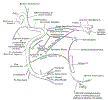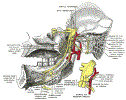Cranial Nerve 7, Cranial Nerve VII, Facial Nerve, CN 7, Geniculate Ganglion, Superior Salivatory Nucleus, Superior Salivary Nucleus
- Causes
- Paralysis
- Multiple Sclerosis
- Neoplasm
- Guillain-Barre Syndrome (Infectious polyneuritis)
- Syphilis
- Bell's Palsy
- Lyme Disease
- Melkersson's Syndrome (Recurrent Bell's Palsy)
- Poliomyelitis
- Amyotrophic Lateral Sclerosis (ALS)
- Syringomyelia
- Brainstem CVA
- Anatomy
- Course to Geniculate Ganglion
-
General
- Facial Nerve originates in four nucleii in pons and Medulla
- All combine to travel via internal auditory meatus into Geniculate Ganglion
- Each side of the forehead is innervated by both Cerebral Hemispheres (but only one peripheral Facial Nerve)
- Forehead IS involved with a peripheral Facial Nerve lesion (LMN) such as in Bell's Palsy
- Forehead IS NOT involved with an UMN deficit from a central lesion such as a CVA
-
Somatic Motor Nucleii
- Most important of the four components
- Innervates Muscles of facial expression (and stapedius)
- Originates in pons at facial nucleus (in the Brainstem somatovisceral region)
- First courses medially within the pons (paradoxical)
- Circles clockwise around 6th Cranial Nerve Nucleus
- Passes anterior to the Fourth Ventricle
- Then exits the pons
-
Visceral Motor Nucleii
- Innervates lacrimal glands (via pterygopalatine Ganglion)
- Innervates submaxillary glands and Submandibular Glands (via submandibular Ganglion)
- Originates in Medulla at Superior Salivatory Nucleus (Superior Salivary Nucleus)
-
Visceral Sensory Nucleii
- Transmits Taste Sensation for anterior two-thirds of Tongue
- Originates in Medulla at solitary tract nucleus
-
Somatic Sensory Nucleii
- Transmits signals of External EarSensation along with CN 9 and 10
- Originates in Medulla at spinal nucleus of Cranial Nerve 5
- Minimal contribution to head Sensation
- Facial innervation is primarily CN 5
- Posterior scalp is primarily spinal nerve 2
- Anatomy
- Geniculate Ganglion to motor branches
- Ganglion within facial canal between labyrinthine and tympanic segments
- Facial Nerve turns 90 degrees to travel inferiorly through stylomastoid foramen
- Facial Nerve branches (motor innervation)
- Temporal branch (forehead and eye)
- Zygomatic branch (vicinity of zygomatic arch)
- Buccal branch (cheek)
- Marginal mandibular branch (jaw line)
- Cervical branch (neck)
- Posterior auricular nerve branch (posterior to ear back to occiput)
- Anatomy
- Innervation
- Contains motor, autonomic, and sensory fibers
- Motor fibers
- Autonomic motor fibers
- Lacrimation
- Vasodilatation and secretion of Salivary Glands (Submaxillary gland, Sublingual Gland)
- Parotid Gland is innervated by CN 9
- Sensory fibers
- Anatomy
- Central
- Distribution
 Lewis (1918) Gray's Anatomy 20th ed (in public domain at Yahoo or BartleBy)
Lewis (1918) Gray's Anatomy 20th ed (in public domain at Yahoo or BartleBy) Lewis (1918) Gray's Anatomy 20th ed (in public domain at Yahoo or BartleBy)
Lewis (1918) Gray's Anatomy 20th ed (in public domain at Yahoo or BartleBy) Lewis (1918) Gray's Anatomy 20th ed (in public domain at Yahoo or BartleBy)
Lewis (1918) Gray's Anatomy 20th ed (in public domain at Yahoo or BartleBy) Lewis (1918) Gray's Anatomy 20th ed (in public domain at Yahoo or BartleBy)
Lewis (1918) Gray's Anatomy 20th ed (in public domain at Yahoo or BartleBy)
- Mandibular
 Lewis (1918) Gray's Anatomy 20th ed (in public domain at Yahoo or BartleBy)
Lewis (1918) Gray's Anatomy 20th ed (in public domain at Yahoo or BartleBy) Lewis (1918) Gray's Anatomy 20th ed (in public domain at Yahoo or BartleBy)
Lewis (1918) Gray's Anatomy 20th ed (in public domain at Yahoo or BartleBy)
- Exam
- Facial Motor Exam
- Forehead and Upper lid Innervation
- Eyebrow elevation
- Forehead wrinkling
- Frowning
- Tight closing of the eyes
- Contrast with CN 3 which opens the eyes
- Lower Face innervation
- Showing teeth
- Whistling
- Puffing cheeks
- Natural smile
- Test or inquire about Taste Sensation
- Forehead and Upper lid Innervation
- Distinguish level of Facial Nerve lesion
- Upper Motor Neuron (UMN Lesion)
- Unless bilateral lesion, does not affect forehead
- Mouth paralysis is overcome by emotional expression
- Lower Motor Neuron (LMN Lesion)
- Ipsilateral forehead and lower face paralysis
- Upper Motor Neuron (UMN Lesion)
- References
- Gilman (1989) Manter and Gatz Essentials of Neuroanatomy and Neurophysiology, Davis, p. 87-113
- Goldberg (2014) Clinical Neuroanatomy, p. 24-39
- Netter (1997) Atlas Human Anatomy, ICON Learning, p. 110-129
